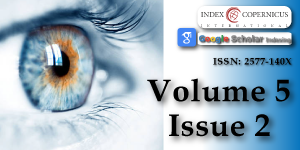A rare presentation of orbital dermoid: A case study
Main Article Content
Abstract
Introduction: A dermoid cyst is a developmental choristoma lined with epithelium and filled with keratinized material arising from ectodermal rests pinched off at suture lines. These are the most common orbital tumors in childhood. They are categorized into superficial and deep. Superficial orbital dermoid tumors usually occur in the area of the lateral brow adjacent to the frontozygomatic suture. Infrequently a tumor may be encountered in the medial canthal area [1], which is the second most common site of orbital dermoids. We report a case where a swelling presented in the medial canthal area without involving the lacrimal system.
Case report: A 43 year old lady presented with complaint of swelling near the (RE; Right eye) since 2 years duration. She presented with a solitary 1.5 cm x 1 cm ovoid, non-tender, non-pulsatile, firm, non-compressible mobile swelling with smooth surface over the medial canthus of right eye. (MRI; Magnetic Resonance Imaging) brain and orbit showed right periorbital extraconal lesion and the (FNAC; Fine Needle Aspiration Cytology) suggested of Dermoid Cyst. RE canthal dermoid cyst excision was done under Local Anasthesia.
Conclusion: Complete surgical excision in to be treatment of choice for dermoids. Since medial canthal mass can involve the lacrimal system, it becomes necessary to perform preoperative assessments using (CT; Computed Tomography), MRI or dacryocystography while planning the surgical approach. Silicone intubation at the beginning of the surgery is an easy and effective way of identifying canaliculi and of preventing canalicular laceration during dermoid excision if the lacrimal system is found to be involved.
Article Details
Copyright (c) 2021 Girimallanavar S, et al.

This work is licensed under a Creative Commons Attribution 4.0 International License.
Hurwitz JJ, Rodgers J, Doucet TW. Dermoid tumor involving the lacrimal drainage pathway: a case report. Ophthalmic Surg. 1982; 13: 377–379. PubMed: https://pubmed.ncbi.nlm.nih.gov/7099526/
Kim NJ, Choung HK, Khwarg SI. Managaement of dermoid tumour in medial canthal area. Korean J Ophthalmol. 2009: 23: 204-206. PubMed: https://pubmed.ncbi.nlm.nih.gov/19794949/
De La Luz Orozco-Covarrubias MA, Salazar-Leon JA, Tamayo-Sanchez L, Duran-McKinster C, Ruiz-Maldonado R. Dermoid cyst connected with the lacrimal canaliculum. Pediatr Dermatol. 1993; 10: 69–70. PubMed: https://pubmed.ncbi.nlm.nih.gov/8493174/
Chawda SJ, Moseley IF. Computed tomography of orbital dermoids: a 20-year review. Clin Radiol. 1999; 54: 821–825. PubMed: https://pubmed.ncbi.nlm.nih.gov/10619299/
Yanoff M, Duker JS. Ophthalmology. Second Edition. Mosby: St Louis. 2004; 397-740.
Pryor SG, Lewis JE, Weaver AL, Orvidas LJ. Pediatric Dermoid Cyst of Head and Neck. Otolarygol Head Neck Surg. 2005; 132: 938-942. PubMed: https://pubmed.ncbi.nlm.nih.gov/15944568/
Russell DS, Rubinstein U. Tumors and tumor like lesions of maldevelopmental origin in, Rubinstein U ed. Pathology of tumours of the nervous system. 5th ed. Baltimore. Md: Williams and Wilkins. 1989; 664-765.
Bonavolonta G, Tranfa F, de Concilis C, Strianese D. Dermoid Cyst: 16 years survey. Ophthlmic Plast Reconstr Surg. 1995: 11: 187-192. PubMed: https://pubmed.ncbi.nlm.nih.gov/8541260/
Pollard ZF, Harley RD, Calhoun J. Dermoid cysts in children. Pediatrics. 1976: 57: 379-382. PubMed: https://pubmed.ncbi.nlm.nih.gov/1256948/
Rootman J. Disease of the orbit. 2nd ed. Philadelphia: Lippincott Williams & Wilkins; 2003; 418–423





